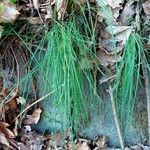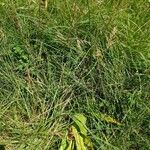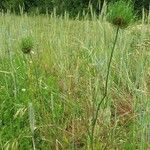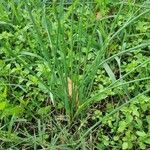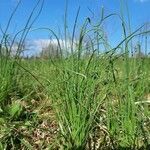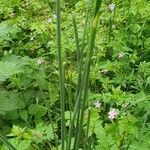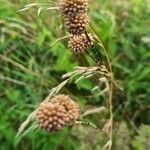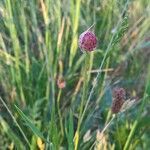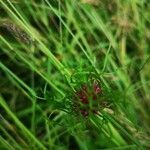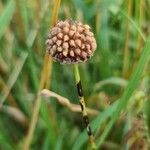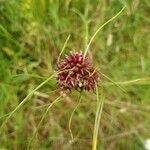Bulb ovoid, 1–2 cm diam.; outer tunics splitting into strips with parallel fibres; bulblets light yellowish brown. Leaves 2–4, sheathing lower ⅓–⅔ of scape, almost cylindrical, hollow, 15–60 cm long, 1.5–4 mm wide. Scape 30–120 cm long, terete. Umbel usually few-flowered, with several to many narrowly obovoid bulbils, sometimes without flowers; pedicels 5–30 cm long, unequal; spathe caducous, entire, shortly beaked. Perianth campanulate; segments c. 3–4.5 mm long, 1.2–1.5 mm wide, obtuse or subacute, smooth, pink or greenish white. Stamens slightly or distinctly exserted; outer 3 filaments simple, 3.5–4 mm long; inner 3 tricuspidate. Capsule 3–3.5 mm long.
Bulb round-ovoid, 1–2 cm; stem slender, 3–10 dm; lvs cauline, few–several, nearly terete except at the base, very slender, mostly 1–2 dm, hollow at least below; umbel erect, subtended by a short invol, often producing only bulblets, these ovoid, usually tipped by a long, fragile, rudimentary lf; normal fls on pedicels 1–2 cm, red-purple or pink, sometimes white or greenish; tep acute or acutish; inner stamens with broad flat filaments, ending in 2 exsert hair-like appendages exceeding the anther; 2n=16, 32, 40. Native of Europe, established as a noxious weed of lawns, fields, and meadows in our range. June.
An onion family plant. It is a bulb plant. The plant has round stems which are almost filled with pith. It can grow 1 m high. The leaves are like cylinders and are hollow. There are 2-4 leaves and they are cylinder shaped. They sheath the lower half of the flowering stalk. The flowers are pink, white or greenish. The young flower heads usually have a bract and a sharp green spike at the top. Some bulbils occur in the head.
